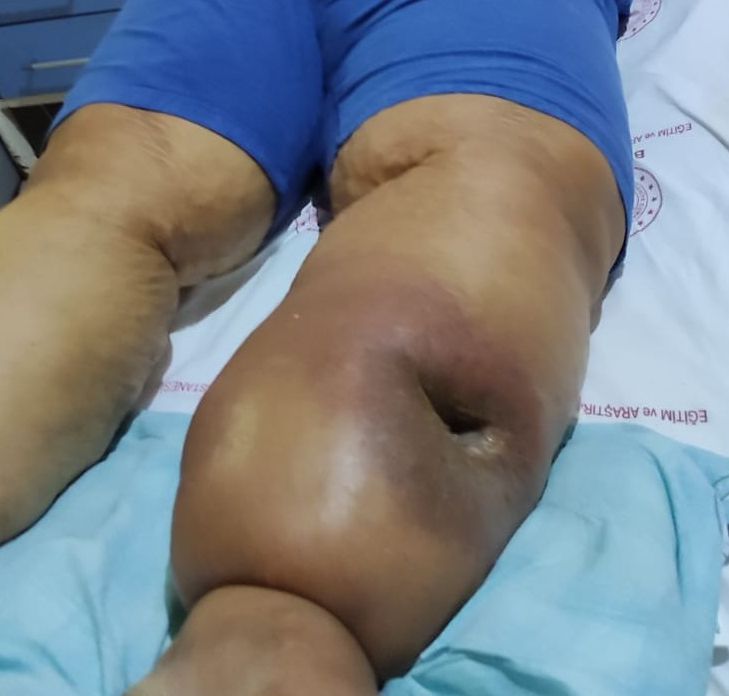Lymphedema in a patient with decompensated cirrhosis
Main Article Content
Abstract
The lymphatic system is critical in body fluid homeostasis. Although lymphatic vascular expansion prevents the development of ascites and oedema in the early stages of liver cirrhosis, compensatory mechanisms cannot achieve this in the advanced stages due to lymphatic dysfunction. A 36-year-old male patient, who had been followed up for cryptogenic cirrhosis for 15 years, had been complaining of excessive swelling in his legs for the last 4 years. Excessive swelling in the legs was accompanied by skin rashes and ulcers, and the leg skin had an orange peel appearance characteristic of lymphedema. Bilateral lower extremity artery and venous system colour Doppler ultrasonography showed that the vascular structures of the right lower extremity arterial and venous system were open, and the flow rate, direction and spectrum were normal. The patient, who could not undergo liver transplantation due to organ limitations, died due to sepsis following lymphedema-induced wound infection. In conclusion, this case suggests that lymphedema should be considered in the presence of oedema in cases of decompensated cirrhosis, and the necessary conservative treatments should be applied.
Downloads
Article Details

This work is licensed under a Creative Commons Attribution-NonCommercial-NoDerivatives 4.0 International License.
References
Biecker,E. Diagnosis and therapy of ascites in liver cirrhosis. World J.Gastroenterol.17,1237–1248(2011).
Runyon, B. A. & AASLD. Introduction to the revised American Association for the Study of Liver Diseases Practice Guideline management of adult patients with ascites due to cirrhosis 2012. Hepatology 57, 1651–1653 (2013).
Chung C, Iwakiri Y. The lymphatic vascular system in liver diseases: its role in ascites formation. Clin Mol Hepatol. 2013 Jun;19(2):99-104. doi: 10.3350/cmh.2013.19.2.99. Epub 2013 Jun 27. PMID: 23837133; PMCID: PMC3701854.
Jeong J, Tanaka M, Iwakiri Y. Hepatic lymphatic vascular system in health and disease. J Hepatol. 2022;77(1):206–218
Burchill MA, Finlon JM, Goldberg AR, Gillen AE, Dahms PA, McMahan RH, et al. Oxidized low-density lipoprotein drives dysfunction of the liver lymphatic system. Cell Mol Gastroenterol Hepatol. 2021;11(2):573–595
Juneja P, Sharma A, Shasthry SM, Kumar G, Tripathi DM, Rajan V, et al. Podoplanin-positive dilated lymphatic vessels in duode- num associates with three-month mortality in patients with cir- rhosis. Front Physiol. 2023;14:1045983
Warren AG, Brorson H, Borud LJ, Slavin SA. Lymphedema: a comprehensive review. Ann Plast Surg. 2007 Oct;59(4):464-72. doi: 10.1097/01.sap.0000257149.42922.7e. PMID: 17901744.
Kumar R, Anand U, Priyadarshi RN. Lymphatic dysfunction in advanced cirrhosis: Contextual perspective and clinical implications. World J Hepatol. 2021 Mar 27;13(3):300-314. doi: 10.4254/wjh.v13.i3.300. PMID: 33815674; PMCID: PMC8006079.
Arya R, Kumar R, Kumar T, Kumar S, Anand U, Priyadarshi RN, Maji T. Prevalence and risk factors of lymphatic dysfunction in cirrhosis patients with refractory ascites: An often unconsidered mechanism. World J Hepatol. 2023 Oct 27;15(10):1140-1152. doi: 10.4254/wjh.v15.i10.1140. PMID: 37970615; PMCID: PMC10642429.

